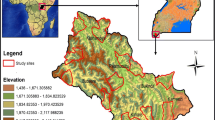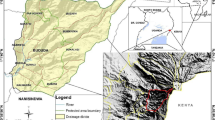Abstract
Topographic attributes have been identified as the most important factor in controlling the initiation and distribution of shallow landslides triggered by rainfall. As a result, these landslides influence the evolution of local surface topography. In this research, an area of 2.6 km2 loess catchment in the Huachi County was selected as the study area locating in the Chinese Loess Plateau. The landslides inventory and landslide types were mapped using global position system (GPS) and field mapping. The landslide inventory shows that these shallow landslides involve different movement types including slide, creep and fall. Meanwhile, main topographic attributes were generated based on a high resolution digital terrain model (5 m × 5 m), including aspect, slope shape, elevation, slope angle and contributing area. These maps were overlaid with the spatial distributions of total landslides and each type of landslides in a geographic information system (GIS), respectively, to assess their spatial frequency distributions and relative failure potentials related to these selected topographic attributes. The spatial analysis results revealed that there is a close relation between the topographic attributes of the post-landsliding local surface and the types of landslide movement. Meanwhile, the types of landslide movement have some obvious differences in local topographic attributes, which can influence the relative failure potential of different types of landslides. These results have practical significance to mitigate natural hazard and understand geomorphologic process in thick loess area.
Similar content being viewed by others
Reference
Baeza C, Corominas J (2001) Assessment of shallow landslide susceptibility by means of multivariate statistical techniques. Earth Surface Processes and Landforms 26: 1251–1263.
Borga M, Fontana DG, Cazorzi F (2002) Analysis of topographic and climatic control on rainfall-triggered shallow landsliding using a quasi-dynamic wetness index. Journal of Hydrology 268: 56–71.
Cruden DM, Varnes DJ (1996) Landslide types and processes. In: Turner AK, Schuster RLE (Eds.), Landslides: Investigation and Mitigation. National Academy Press, Washington DC, USA. pp 36–75.
Derbyshire E (2001) Geological hazards in loess terrain, with particular reference to the loess regions of China. Earth-Science Reviews 54: 231–260.
Derbyshire E, Dijkstra TA, Smalley IJ, et al. (1994) Failure mechanisms in loess and the effects of moisture content changes on remoulded strength. Quaternary International 24: 5–15.
Derbyshire E, Mellors TW (1988) Geological and geotechnical characteristics of some loess and loessic soils from China and Britain: A comparison. Engineering Geology 25: 135–175.
Dietrich WE, Reiss R, Hsu ML, et al. (1995) A process-based model for colluvial soil depth and shallow landsliding using digital elevation data. Hydrological Processes 9: 383–400.
Dijkstra TA, Rogers CDF, Smalley IJ, et al. (1994) The loess of north-central China: Geotechnical properties and their relation to slope stability. Engineering Geology 36: 153–171.
Fernandes NF, Guimarães RF, Gomes RAT, et al. (2004) Topographic controls of landslides in Rio de Janeiro: field evidence and modeling. Catena 55: 163–181.
Gao J, Maro J (2010) Topographic controls on evolution of shallow landslides in pastoral Wairarapa, New Zealand, 1979–2003. Geomorphology 114: 373–381.
Handy RL (1973) Collapsible loess in Iowa. Soil Science Society of America Proceedings 37: 281–284.
Hennrich K, Crozier MJ (2004) A hillslope hydrology approach for catchment-scale slope stability analysis. Earth Surface Processes and Landforms 29: 599–610.
Iida T (1999) A stochastic hydro-geomorphological model for shallow landsliding due to rainstorm. Catena 34: 293–313.
Meisina C, Scarabelli S (2007) A comparative analysis of terrain stability models for predicting shallow landslides in colluvial soils. Geomorphology 87: 207–223.
Montgomery DR, Dietrich WE (1994) A physically based model for the topographic control on shallow landsliding. Water Resources Research 30: 1153–1172.
Montgomery DR, Schmidt KM, Greenberg HM, et al. (2000) Forest clearing and regional landsliding. Geology 28: 311–314.
O’Callaghan JF, Mark DM (1984) The extraction of drainage networks from digital elevation data. Computer Vision Graphics Image Processes 28: 323–344.
Roering JJ (2004) Soil creep and convex-upward velocity profiles: theoretical and experimental investigation of disturbance-driven sediment transport on hillslopes. Earth Surface Processes and Landforms 29: 1597–1612.
Šajgalik J (1990) Sagging of loesses and its problems. Quaternary International 7–8: 63–70.
Talebi A, Uijlenhoet R, Troch PA (2008) A low-dimensional physically based model of hydrologic control of shallow landsliding on complex hillslopes. Earth Surface Processes and Landforms 33: 1964–1976.
Varnes DJ, Commission on Landslides of the IAEG (1984) Landslide Hazard Zonation: a Review of Principles and Practice. UNESCO, Paris.
Zevenbergen LW, Thorne CR (1987) Quantitative analysis of land surface topography. Earth Surface Processes and Landforms 12: 47–56.
Author information
Authors and Affiliations
Corresponding author
Rights and permissions
About this article
Cite this article
Zhang, F., Chen, W., Liu, G. et al. Relationships between landslide types and topographic attributes in a loess catchment, China. J. Mt. Sci. 9, 742–751 (2012). https://doi.org/10.1007/s11629-012-2377-7
Received:
Accepted:
Published:
Issue Date:
DOI: https://doi.org/10.1007/s11629-012-2377-7




